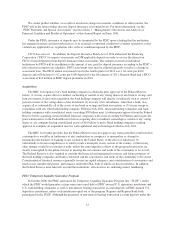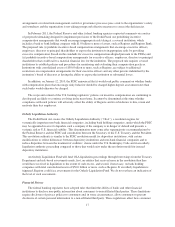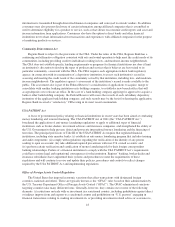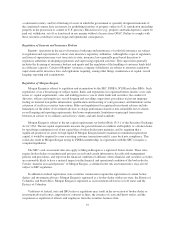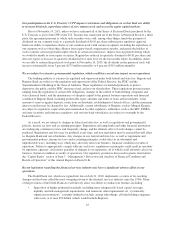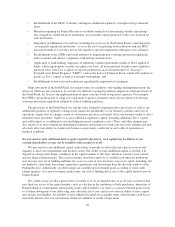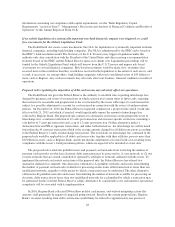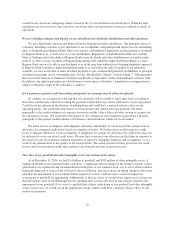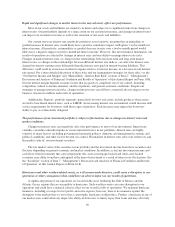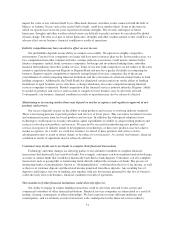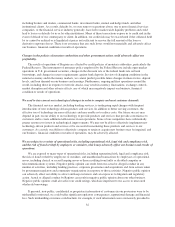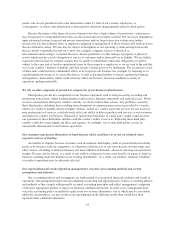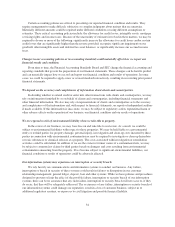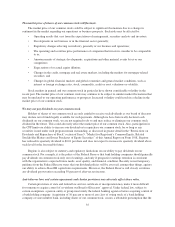Regions Bank 2010 Annual Report Download - page 39
Download and view the complete annual report
Please find page 39 of the 2010 Regions Bank annual report below. You can navigate through the pages in the report by either clicking on the pages listed below, or by using the keyword search tool below to find specific information within the annual report.Our participation in the U.S. Treasury’s CPP imposes restrictions and obligations on us that limit our ability
to increase dividends, repurchase shares of our common stock and access the equity capital markets.
Prior to November 14, 2011, unless we have redeemed all of the Series A Preferred Stock purchased by the
U.S. Treasury as part of the CPP or the U.S. Treasury has transferred all of the Series A Preferred Stock to a third
party, the agreement pursuant to which such securities were sold, among other things, limits the payment of
dividends on our common stock to a quarterly dividend of $0.10 per share without prior regulatory approval,
limits our ability to repurchase shares of our common stock (with certain exceptions, including the repurchase of
our common stock to offset share dilution from equity-based compensation awards), and grants the holders of
such securities certain registration rights which, in certain circumstances, impose lock-up periods during which
we would be unable to issue equity securities. Regions has reduced its quarterly dividend to $0.01 per share and
does not expect to increase its quarterly dividend above such level for the foreseeable future. In addition, unless
we are able to redeem the preferred stock prior to November 15, 2013, the dividends on the preferred stock will
increase substantially, from 5 percent ($175 million annually) to 9 percent ($315 million annually).
We are subject to extensive governmental regulation, which could have an adverse impact on our operations.
The banking industry is extensively regulated and supervised under both federal and state law. Regions and
Regions Bank are subject to the regulation and supervision of the Federal Reserve, the FDIC and the
Superintendent of Banking of the State of Alabama. These regulations are intended primarily to protect
depositors, the public and the FDIC insurance fund, and not our shareholders. These regulations govern matters
ranging from the regulation of certain debt obligations, changes in the control of bank holding companies and
state-chartered banks, and the maintenance of adequate capital to the general business operations and financial
condition of Regions Bank, including permissible types, amounts and terms of loans and investments, to the
amount of reserves against deposits, restrictions on dividends, establishment of branch offices, and the maximum
interest rate that may be charged by law. Additionally, certain subsidiaries of Regions, such as Morgan Keegan,
are subject to regulation, supervision and examination by other regulatory authorities, such as the SEC, FINRA
and state securities and insurance regulators, and our non-bank subsidiaries are subject to oversight by the
Federal Reserve.
As a result, we are subject to changes in federal and state law, as well as regulations and governmental
policies, income tax laws and accounting principles. Regulations affecting banks and other financial institutions
are undergoing continuous review and frequently change, and the ultimate effect of such changes cannot be
predicted. Regulations and laws may be modified at any time, and new legislation may be enacted that will affect
us, Regions Bank and our subsidiaries. Any changes in any federal and state law, as well as regulations and
governmental policies, income tax laws and accounting principles, could affect us in substantial and
unpredictable ways, including ways which may adversely affect our business, financial condition or results of
operations. Failure to appropriately comply with any such laws, regulations or principles could result in sanctions
by regulatory agencies, civil money penalties or damage to our reputation, all of which could adversely affect our
business, financial condition or results of operations. Our regulatory position is discussed in greater detail under
the “Capital Ratios” section of Item 7. “Management’s Discussion and Analysis of Financial Condition and
Results of Operation” of this Annual Report on Form 10-K.
Recent legislation regarding the financial services industry may have a significant adverse effect on our
operations.
The Dodd-Frank Act, which was signed into law on July 21, 2010, implements a variety of far-reaching
changes and has been called the most sweeping reform of the financial services industry since the 1930s. Many
of the provisions of the Dodd-Frank Act will directly affect our ability to conduct our business including:
• Imposition of higher prudential standards, including more stringent risk-based capital, leverage,
liquidity and risk-management requirements, and numerous other requirements on “systemically
significant institutions,” currently defined to include, among other things, all bank holding companies
with assets of at least $50 billion (which would include Regions);
25


